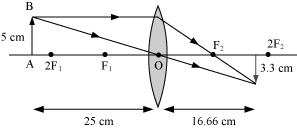NCERT Solution: Light Reflection and Refraction
Where should an object be placed in front of a convex lens to get a real image of the size of the object?
(a) At the principal focus of the lens
(b) At twice the focal length
(c) At infinity
(d) Between the optical centre of the lens and its principal focus.
ANS (b) At twice the focal length
A spherical mirror and a thin spherical lens have each a focal length of -15 cm. The mirror and the lens are likely to be
(a) both concave
(b) both convex
(c) the mirror is concave and the lens is convex
(d) the mirror is convex, but the lens is concave
ANS (a) both concave
No matter how far you stand from a mirror, your image appears erect. The mirror is likely to be
(a) plane
(b) concave
(c) convex
(d) either plane or convex
ANS (d) either plane or convex
Which of the following lenses would you prefer to use while reading small letters found in a dictionary?
(a) A convex lens of focal length 50 cm
(b) A concave lens of focal length 50 cm
(c) A convex lens of focal length 5 cm
(d) A concave lens of focal length 5 cm
ANS (c) A convex lens of focal length 5 cm
A concave mirror gives an erect image when an object is placed between its pole (P) and the principal focus (F).
Hence, to obtain an erect image of an object from a concave mirror of focal length 15 cm, the object must be placed anywhere between the pole and the focus. The image formed will be virtual, erect, and magnified in nature, as shown in the given figure.
(a) Concave Mirror: This is because concave mirrors can produce powerful parallel beam of light when the light source is placed at their principal focus.
(b) Convex Mirror: This is because of its largest field of view.
(c) Concave Mirror: This is because it concentrates the parallel rays of sun at principal focus.
Case I
When the upper half of the lens is covered In this case, a ray of light coming from the object will be refracted by the lower half of the lens. These rays meet at the other side of the lens to form the image of the given object, as shown in the following figure.
Case II
When the lower half of the lens is covered In this case, a ray of light coming from the object is refracted by the upper half of the lens. These rays meet at the other side of the lens to form the image of the given object, as shown in the following figure.
Object height, ho = 5 cm
Focal length, f= +10 cm
According to the lens formula,

The positive value of shows that the image is formed at the other side of the lens.

The negative sign shows that the image is real and formed behind the lens.

The negative value of image height indicates that the image formed is inverted.
The position, size, and nature of image are shown in the following ray diagram.

Real, inverted, diminished.